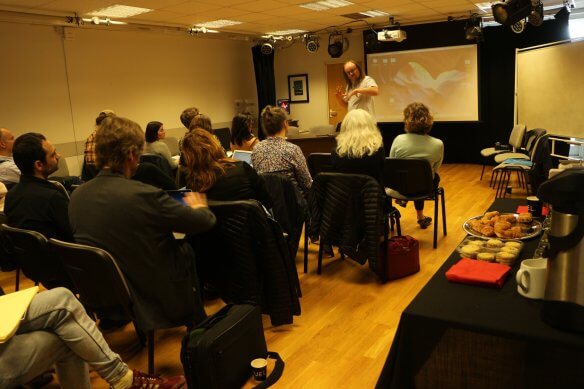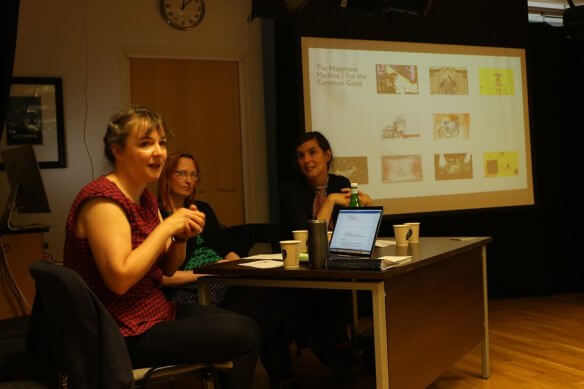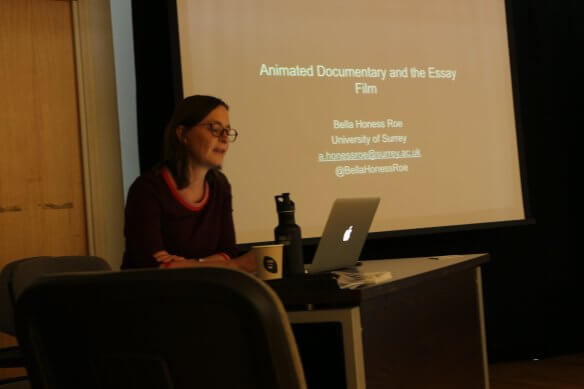The Essay Film Form and Animation: Intersectionality in Motion Conference Report
The 2019 Essay Film Form and Animation: Intersectionality in Motion conference held at the Derek Jarman Lab in London, between the 12th and 13th June was well attended. The conference was supported by the Arts University Bournemouth, the Society for Animation Studies, The British Association of Film, Television and Screen Studies, CAPA Global Education Network, and the Derek Jarman Lab. Professor Paul Ward, Dr Romana Turina, and Dr Bartek Dziadosz gathered a broad range of participants, from students, academics, practitioners and teachers, who came together to talk about various subjects that arose from the ideas of intersectionality, animation documentary and the essay film. Delegates came from across the world to present papers and discuss in detail the work at the centre of their research and practice.

Paul Ward (CAPA, Kensington, London)
The papers presented span a broad range of subjects and included some particularly thought-provoking and insightful ways of working and developing research when using a biographical and ethnographic stance. Some of the highlights included a presentation by Susan Young from the Royal College of Art, London. Her paper, titled ‘Using Animated Autoethnography to Resist and Reframe Psychiatric Othering and Iatrogenic Harm’, was a thoroughly enthralling personal account into her relationship with mental health and the health care providers that were put in place to help. Her work is highly autoethnographic and had great visual and ethical depth that brought together aspects of both the essay film concept and social research. Followed by Sally Pearce (Wolverhampton University)’s ‘Subversively Claustrophobic Spaces in Woman’s Animated Autobiography’, which discussed the spaces in which women in animated films live and fill with their bodies, this paper densely described this subject within the parameters of documentary film.
Faiyaz Jafri from Parsons School of Design and Queens College in New York, began by presenting his film This Ain’t Disneyland (2015) which documented his firsthand account of the 9/11 terrorist attack. His paper ‘The Illusion of Destruction’ discussed the event, his approach to the film and the end of Postmodernism. This paper gave another dynamic to the discussion of essay films by presenting the film alongside the analysis and theoretical framework of its creation, it enacted the idea that an essay is in itself a discussion on a topic – in this case destruction and postmodernism, with a very specific meaning to its creator but a certain amount of critical evaluation and open-endedness for the audience.
Samantha Langsdale from the University of North Texas’s paper ‘You are like me: Intersectionality Strengths and Weaknesses in Spider-Man: Into the Spider-Verse (2018)’ applied the writing and discussion of intersectionality to the 2018 film Spider-Man: Into the Spider-Verse in which the main character is a young Afro-Latino male. This led to an open-ended discussion about whether intersectionality and commercial film production can work together, or by definition are unable to be perceived as genuine or sincere attempts to better understand and represent marginalised people.

Sam Moore, Abigail Addison & Lizzie Hobbs (CAPA, Kensington, London)
There were also more unique events that included a talk from filmmakers Lizzie Hobbs and Samantha Moore, as well as producer Abigail Addison, whose new project The Happiness Machine was commissioned to illustrate, elucidate and highlight ‘The Common Good’ economic model. The films were unique and offered very different takes on the subject matter, as well as potentially showing the use of essay films and animated documentary.
The keynote was provided by the highly respected authority on animated documentary Annabelle Honess Roe, whose talk drew links between animation and the essay film as well as the difficulty of defining and separating the two fields of essay and documentary filmmaking. Andy Holden presented his new essay film Laws of Motion in a Cartoon Landscape (2018); a roundtable chaired by Bartek Dziadosz from Derek Jarman Lab discussed the film and offered up further discussion about the role of animation in the essay film.
A varied range of takes on what an essay film actually is, should and could be, the essay film as a subject raised much debate, especially when presented alongside animation and animated documentary as it seems hard to decipher the differences, as much of what would make a film an essay film is intrinsically linked to animated documentary. This in turn prompted lively debate about whether or not essay films work within the context of animation documentary or if, by definition, animated documentary is (and surpases, to a certain degree) an essay film. The clear overlap of all these subjects made for a rich source of discussion, with two days proving not to be enough. While more discussion would be valuable in future the keynotes and talks opened yet more definitions, consideration and potential avenues for exploration. These papers and essays now live in our minds but would benefit from further analysis, further discussion and new eyes to be cast upon them. I believe that this form has great potential for rafting the difficult interplay between both practice and academia; between makers and thinkers. The essay structure, much like documentary (if indeed they are separate things), is a great companion to the animation academic’s arsenal, providing a clear union even if its definition is not yet clear in itself.

Annabelle Honess Roe (CAPA, Kensington, London)
What I found particularly interesting was this link between practice and the written or theoretical framework around the films. This struck me as the defining nature of what would or could be defined as an essay film, an open, multiple positioned film about a subject. However, this theoretical framework and the idea of both being passionate in our exploration of a subject whilst not fully stating our position, seems to be the potential difference between essay and documentary. It would seem that a documentary film may be at least be partly essay and an essay film is often similar to documentary, but perhaps it’s the idea of ‘may’, ‘can’, ‘often’ and ‘potentially’ that allows the essay film to straddle a position between fiction and nonfiction, biographic and ethnographic, taking the definition back to the word ‘essay’ itself, which is a piece of writing. The essay film can be musing on a subject and doesn’t require the defining features a documentary may need. Yet, similarly to documentary, which seems to deal in certainty and facts, essay films can reveal unexplored information but can also be less-defined and more fluid. These elements can be found in Turina’s films Lunch with Family (2016) and San Sabba (2016), who is the driving force behind the organisation of this conference.
The papers presented would have great application for researchers and practitioners alike, potentially reframing and opening up the categorisation of films while giving new scope to both the fields of animation and essay films. There were works of film presented during the conference that could offer unique approaches to creating as well as research methods, especially as regards the realm of practice-based/led research when combined with film or animation.

